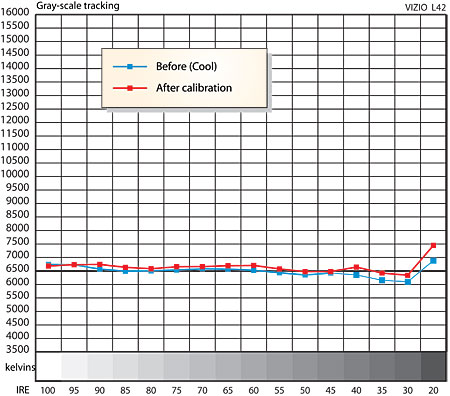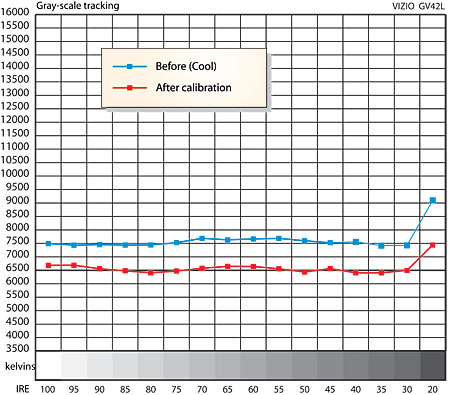VIZIO L42HDTV and GV42L LCDs Vs. VIZIO P42HDTV Plasma Page 3
Before calibration, the Cool setting of the Color Temperature control produced the most accurate results. Both Normal and Warm produced images with an unacceptable excess of green, and Warm also had too much red as well. After calibration, however, the gray scale was far more acceptable, apart from a rise to just under 7500 Kelvins at the dark end of the scale (20IRE). The improvement isn't all that visible in the chart, since it was not so much in the Kelvin temperatures as in the fact that the post calibration results were closer to the true D6500 standard. Pre-calibration, there was too much green in the results, particularly at low light levels where this deviation will be most visible—and annoying.

Despite the lack of both high and low level controls for red, green, and blue, the set was very easy to bring into proper adjustment. It took me less than half an hour with our Photo Research PR-650 to set up the input I used for most of my viewing (HDMI)—though a full calibration for other inputs (recommended) would undoubtedly take longer. The only problem the gray scale calibration did not cure was some red push on flesh tones; I dialed the Color control down to 45, which helped without seriously compromising other colors.
The set's color points, while not perfect, were good, and comparable to those of most other digital sets we have measured.
The L42HDTV's HDMI resolution at 720P was good to the highest burst on my AccuPel test pattern generator (37.1MHz). With a 1080i input, there are visible resolution lines at 37.1MHz, but they are no finer than the lines at 18.5MHz. Both 480i and 480p are good to their maximum format resolution limits of 6.75MHz and 13.5MHz, respectively. With a component input, the results were virtually the same at 720p and 1080i as HDMI. At 480p the result was fine to 13.5MHz. At 480i the resolution lines are visible at this resolution's maximum of 6.75MHz, but are clearly reduced in level, indicating that the response begins rolling off below this frequency.
One flaw was visible at all resolutions in both HDMI and component. Vertical black lines on the sharpness pattern from my test pattern generator had clear white lines on both sides of them, even with the Sharpness control set to zero. This sharpening can't be turned off by the user. A 720p component input from my test pattern generator produced the cleanest measured result, though it also showed some visible, non-defeatable sharpening.
But the visibility of this excess sharpening was elusive on most program material, since it was most evident on black vertical lines against a light gray or black background. Nevertheless, the effect of any set's Sharpness control should be completely defeatable by the user, should he or she desire to dial it out. According to VIZIO there is no hidden service menu that might provide a way to eliminate this problem, or at least none to which they volunteered to share the access codes.
With a 480i input the set's scaling and deinterlacing was merely fair. It passed our 3/2 pulldown tests but didn't do very well on the 2/2 cadence (non film-based video) tests. There is no film/video option in the menu; the set's switching between the two modes is automatic and apparently not particularly effective. The L42HDTV also showed more jaggies than we've seen from our standard tests on most displays we've tested recently. But these issues were not as frequent or distracting in real world viewing as the test pattern results might seem to indicate.
With the set calibrated for the best image I measured a peak contrast level of 681:1 (47 foot-Lamberts peak white, 0.069fL video black). For comparison, the P42HDTV plasma (a new sample) measured 928:1 using a 100IRE window pattern (46.4fL/ 0.05fL) or 430:1 with a full-screen 100IRE white field (21.5fL/0.05fL).
Finally, the L42HDTV's overscan averaged around 4% in component. In HDMI it varied from 2% to 6.5% in 480i and 480p and was approximately 2% off center both left-right and top-bottom at both of those resolutions. It was 4% at 720p and 3.5% in 1080i, in HDMI, and properly centered at both of those resolutions.
Tests: GV42L
The distinguishing physical features of the VIZIO GV42L include a small, rounded trim plate centered in the area below the glossy black screen frame. The GV42L's speakers can be removed to give the TV the "picture frame" look offered by many other flat panel TVs. And while the GV42L's remote looks the same and has an identical layout as the remotes for the P42HDTV and L42HDTV, it adds backlighting for use in dark environments.

The GV42L's distinguishing operational feature is an Advanced Picture Adjust submenu (a menu which does not exist in the L42HDTV), offering six additional controls. These are DNR (Dynamic Noise Reduction), Black Level Extender, White Peak Limiter, CTI (Color Transient Intensity), Flesh Tone, Adaptive Luma, and Dynamic Contrast.
I did experiment extensively with the two of these controls whose names suggested that they might improve the set's contrast ratio and/or black level: Black Level Extender and Dynamic Contrast. I'll have more on what they did a bit further on, but the bottom line is that they didn't really help in providing better blacks. The viewing tests below were performed with all of these Advanced Adjust controls turned Off.
Apart from the above additions, the description of the features and operation of the L42HDTV, above, also apply to the GV42L.
Performance: GV42L
From what I could see, I suspect that the L42HDTV and GV42L are very similar internally, though perhaps with different LCD panels. It's interesting just how close they were in picture quality, with the GV42L's performance virtually identical to that of the L42HDTV. It had the same strengths (a bright, colorful, sharp image) and the same weaknesses (oversharpening that's visible mostly on test patterns, so-so scaling and deinterlacing, and poor blacks and shadow detail).
The GLV42L did display one flaw not present in the L42HDTV LCD. A full black screen image on the latter, though more gray than black, was a least an even, uniform shade of gray. On the GV42L a black screen image looked blotchy, with some areas slightly darker than others. The darker areas were larger than what you'll see with fixed pattern noise.
Tests: GV42L
The GV42L's measured performance, like its images, was startlingly close to that of the L42HDTV. The Cool setting of its Color Temperature control produced the best pre-calibration results, although the GV42L was further from the ideal D6500 than the L42HDTV. Warm and Neutral had too much red and green. The GV42L had similar color points, and similar ease of calibration with only a single set of R, G, and B controls provided, as in the L42HDTV. I didn't notice as much of a red push in the GV42L as in the L42HDTV, though I still dropped the Color control a step or two below its midpoint, depending on the program material.
The GV42L's HDMI resolution was similar to that of the L42HDTV in most ways, but a 480i component input was so dramatically reduced in resolution at 6.75MHz on the GV42L that I would not recommend using 480i component for critical sources on this set.
I measured a peak contrast of 572:1 for the GV42L—34.3fL peak white, 0.06fL video black. Interestingly, this is a slightly better (lower) black level than I measured from the L42HDTV, but not enough to make a substantial visible difference. With the Dynamic Contrast feature turned On, the contrast ratio increased to 1072:1. But the increase here came by way of a jump upward in peak white accompanied by a smaller upward jump in the black level—110.4fL peak white, 0.103fL video black—so it provided, in my opinion, no real improvement.
Turning on the Black Level Extender feature, either with or without Dynamic Contrast, made little difference in the static test results above, or, as far as I could see, in real world viewing.
The GV42L's overscan averaged about 4% in component and HDMI. As with the L42HDTV, the 480i and 480p images in HDMI were off center, by approximately 1.5-2% in both the horizontal and vertical directions.
Conclusions: GV42L
The measurement and viewing results suggest that the GV42L is essentially the same chassis, performance-wise, as the L42HDTV, with slightly modified cosmetics and a few additional features that may or may not be useful to you (for me, they were not). Yes, as noted in the review comments above, I slightly preferred the L42HDTV, but I feel comfortable suggesting that you would be on safe ground choosing between these two units on the basis of cosmetics, price, and features.
Highs and Lows (L42HDTV and GV42L)
Highs
Bright, vivid, crisp image
Exceptional value for money
Lows
Mediocre black level and shadow detail
Deinterlacing and scaling subpar
Non-defeatable edge enhancement




























































